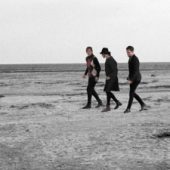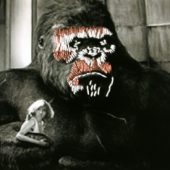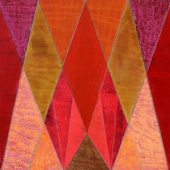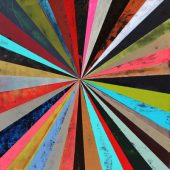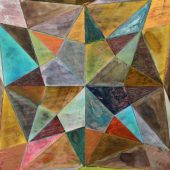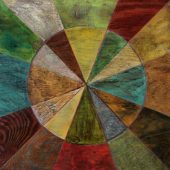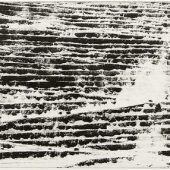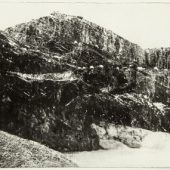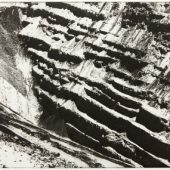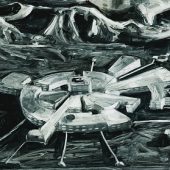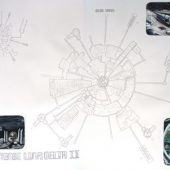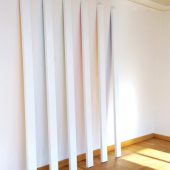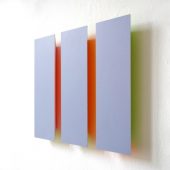Charlotte Bastian, Kiki Gebauer, Simone Häckel, Christine Niehoff, Annette Sonnewend and Bettina Weiß
05.25 — 06.28.14
Mistakes Have Hidden Intention features Berlin-based artists Charlotte Bastian, Kiki Gebauer, Simone Häckel, Christine Niehoff, Annette Sonnewend and Bettina Weiß, all of whom are affiliated with Scotty Enterprises, a six-year-old gallery project based in Kreuzberg.
The opening reception is on Sunday, May 25, 4 – 7pm; the show continues until June 28th.
Mistakes, blind gaps and missteps are curiously effective triggers to open space. Errors signal new options and dimensions; failures lead to creative solutions. In Mistakes Have Hidden Intention, these ripples of continuity act as the connective tissue joining the work of six artists living and working in Berlin.
The glitch, the crack and the flaw all plead for space. They’re a breach of rules, a blink in perception. They restore depth to pictures, videos and/or installations and when considering the cut in a film, the break is the mysteriously absent space between two scenes. This gap allows the viewer to get in, to enter the story and ultimately to engage. Fantasy is a way of continuing the story; it works it through.
For Jean-Luc Godard the cuts in film were the redemption of reality: Particularly through it breaks and dithers; cinema generates reality. The breaks are like dashes. In this exhibition the artists apply these moments of silence, visualizations of the hidden and reversing of gears to the work offered . They approach the project through varied means. The exhibition will include painting, drawing, sculpture, video and installation.
We’re also very pleased to continue working with Seth Hunter on Ecotone, a recent program at devening projects + editions featuring interventions triggered by the interstitial spaces between our main gallery and the off space. In his sixth project, Chicago artist Seth Hunter presents training a train wreck at the May 25th opening. As an artist-in-residence in the gallery between July 2013 and July 2014, Hunter has been working with, in and around the area to activate links between his own conceptual interests and the physical space. training a train wreck is comprised of three works and an edition focused on humanity and its inevitable failures. Hunter is interested in the way one navigates existence, both individually and collectively, when the faced with trouble and pain. Coinciding with each main-gallery exhibition he will produce and present seven different editions.
BIOS:
Simone Häckel studied art at Kunsthochschule Kassel and Experimental Media Design at the Berlin University of the Arts where she received her Meisterschüler degree in 2008. Since 2002, her focus has been video. She is interested in sites, people and human actions beyond the visible. She examines the aspirations and dreams of humans and the state of humanity as such, beyond only physical experience. By using documentary techniques she draws topographies of the desires and realities of children and adults. Her projects are cross-cultural, located in various regions (Germany, Turkey, India) She examines the cultural intersections and differences in an increasingly globalized world.
Her work is represented in various collections including the Burger Collection, Hong Kong, the Teutloff Video Collection in Bielefeld, Germany and the Gideon Collection in Geneva, Switzerland. Her videos have been shown at numerous exhibitions and film festivals, including the Museum Salzburg, the Deutsches Hygiene Museum, Dresden, the Gallery 1Shanthiroad, Bangalore Indien and the European Media Art Festival EMAF in Osnabrück. She has received various stipends and prizes from among others, the Käthe Dorsch and Agnes Straub Stiftung Berlin and the Senat für kulturelle Angelegenheiten, Berlin.
www.simonehaeckel.com
Kiki Gebauer’s sculptural works include large outdoor projects and exhibition-based installations. Recently she was part of Le Chant de Mon Chantier at the Galerie Immanence in Paris and Ende in Kunstverein Schwerin, curated by Dr. Julia Wirxel. Her work was part of the opening of the new Potsdam-Museum 2012 and Paradestuecke, Schloss Sakrow. She won the Art-Prize Tempelhof-Schoeneberg 2009 and was the prizewinner of Aktion-Baukultur in 2011. Since 2001, her 40 meter long Watersigns have been shown in Berlin along the river Spree and 2004 during Canalscapes of Scotland, Demarco European Art Foundation, Edinburgh curated by Charles Ryder. In June she will present a set of new signs at Notaufnahmelager Berlin-Marienfelde.
www.welt-weit-wasserzeichen.de
Christine Niehoff’s work deals with the grey area between fact and fiction, where fiction becomes a blueprint for reality and where reality is increasingly presented according to the laws of entertaining fiction. In this context, she explores the position of the individual in relationship to society and its grand narratives: myths, ideologies or more everyday narrative structures such as TV shows, film plots and genres. They all provide patterns of meaning that consciously or unconsciously influence the way we understand ourselves and the world. Openly playing with artifice and realism as well as with high and low tech, her subject matter has increasingly become focused on the future of mankind, on science fiction in the sense that an imagined future is used to comment on potentially sinister events and developments in our present world. In her extensive research for each work she makes equal use of both fictional and factual/scientific sources.
Christine Niehoff’s work is currently shown in the two-person-show Koala & Pepys at Delikatessenhaus in Leipzig, Germany. Recent group shows include Le Chant de Chatier at Galerie Immanence in Paris, Heute Hier – Bugün Burada at Haus am Kleistpark (Berlin), Körnelia – Goldrausch 2013 at Galerie im Körnerpark in Berlin and Ende at Kunstverein Schwerin in Schwerin, Germany. In November 2014 she will be featured in a solo show at Kunstraum Potsdam. She is a graduate of Glasgow School of Art (BA) and Goldsmiths College, London (MFA). In 2013 she was awarded the Goldrausch Art IT scholarship. www.christine-niehoff.net
Borrowing heavily from already existing artworks, films, TV, novels and theoretical writing, the art of Annette Sonnewend revolves around the small section of actualized and failed models of modernism. Her works address personal and social issues; both the private and the political. In one recent series called The Lover proudly presents: A Collection! she constructs sequences of experiments in which authentic and possible events are combined with the fictive to create a web of clues that function in an indeterminate sphere. Annette Sonnewend sees the world as only one of many possible versions. The idea of creating new realities, and acquiring the space as a timeless person, forms the basis of the reconstructions of film space, social space, situations in scale models. Involving oneself in various contexts, regardless of space and time, switching back and fort between reality and fiction, dream-like and somnambulistic, is how Annette Sonnewend produces subjectivity.
In Chicago she is presenting Tracing the Trail – a personal /subjective archive of choreographies of films across film history (still in progress). Inside the postmodern cultural studies the term archive is used as memory of information and knowledge, referring Jacques Derrida and Michel Foucault. It s a project about choreography – developed as a form of writing.
Annette Sonnewend has recently shown her work at Immanence, Paris, das weisse haus, Vienna and Scotty Enterprises Berlin. In 2009 she received the National Grant for Artistic Photography of the Federal Chancellery of Austria (bm:ukk). In 2004, she received the award for Contemporary Art of the Land Tirol, Austria. In addition she was awarded the Fellowship for Artistic Photography of the Federal Chancellery of Austria (bm:ukk) in London, GB, Fellowship for Fine Arts of the bm:ukk in Chicago, USA, the Fellowship for Artistic Photography of the bm:ukk in Paris, France, the AIR program of the Province of Tyrol in Paliano, Italy, the AIR program, Pépinières européenne pour jeunes artistes in Lyon, France.
www.annettesonnewend.com
Charlotte Bastian’s works focus on different borderline situations that are explored and ingeniously varied. Colors, textures, skins are pulled over one another, layered and intertwined. Her approach to printing techniques are varied and range from photo transfers to woodcuts. The work fluctuates between a space of real experience and a pictorial world underscored by scenes in which amorphous shapes and architectural elements are generated through an indecisive space, or a mountain formation appears in reversed lighting.
In her photo etchings Bastian is particularly interested in creating the greatest possible distance from the original photographic image; taking the etching beyond the template and developing it into something new. The prints show man-made aternations to various landscapes, especially those caused by the quarrying of resources and its consequences. The intention behind this transformation of landscape, nature and climate is not concealed: economic interests justify the mistakes that are being made.
Some of Charlotte Bastian’s most recent solo exhibitions include Splitter at Scotty Enterprises in Berlin; On the Edge at International Academy for Nature Conservation of the Federal Agency for Nature Conservation, Isle of Vilm; and Beautiful Truth at Galerie dorisberlin in Berlin, Germany. Her recent group exhibitions include Le Chant de Chatier at Immanence, Paris, France; KI at Kunstquartier Bethanien, Berlin; Out of Site at European Month of Photography, Berlin; Freigang at Nachtspeicher23, Hamburg, Germany. Her work has also been featured at Preview Berlin. She lives and works in Berlin, Germany.
www.charlotte-bastian.de
In her work, Bettina Weiß develops tangible sculptural works on wooden canvases. The results seem to be formal solutions which are developed, in contrast to their systematic guise, out of a spontaneous intuition. A process she calls intuitive constructivism. Inaccuracies and material damage are not covered up but integrated into the work process or just simply accepted and worked into the piece. For her, the defects, blemishes and inaccuracies which may appear to be a “mistake” are what forms part of the personal distinction of the work. Fortuity can evoke mistakes which are formally treated in the same way as those that are highly calculated. She makes references to the beginnings of abstract art, counting the Norwegian artist Hilma af Klint, the Russian Frantisek Kupka or Sonja and Robert Delaunay as her influences. Since 2011 Bettina Weiß’s wooden pieces have, have been based on the floral ornamentation found in eastern cultures, developed a geometrically abstract, intensely colorful expressiveness.
Bettina Weiß began studying art in 1996 at the art school in Kassel, Germany under Professor Rob Scholte. In 1999 she enrolled at the UDK in Berlin to study under Prof. Leiko Ikemura and successfully graduated from her master class in 2004. Since 2000 her works have been shown internationally in numerous solo and group exhibitions.
www.bettinaweiss.net
